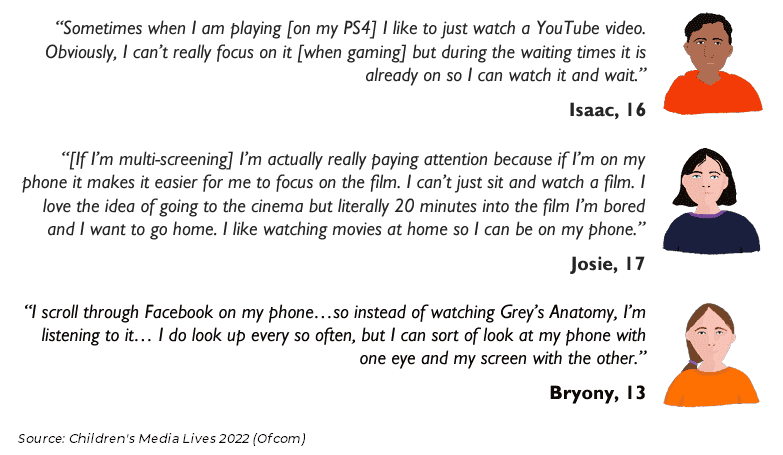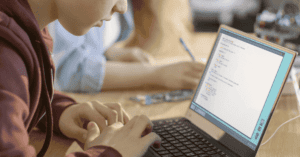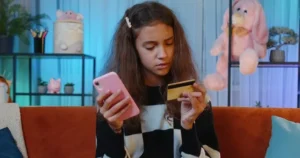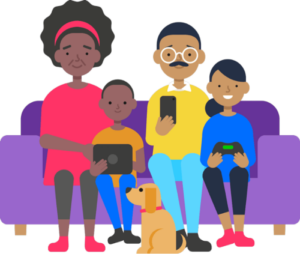Dual-screening is common among multi-device owners, but how does it impact children? Experts Andy Robertson, John Carr and Parven Kaur weigh in.
What is dual-screening?
Dual-screening is when someone uses multiple devices or screens at once. This is sometimes called multi-screening, screen stacking or media multitasking. Because dual-screening forces the user to divide their attention, concerns about the impact on young people have arisen.
Research from Ofcom
The Children’s Media Lives 2022 report* found that children had shorter attention spans and so, avoided long-form content. Moreover, when they did engage in long-form content, they often used another screen as well.

While dual-screening appeared in previous reports, the habit was “both more widespread and more compulsive” in the 2022 research.
When it comes to TV, just 4% of children said they never did anything else while watching. On the other hand, 15% said they watched TV while doing their homework.**
See what our experts say:
Research into dual-screening
Earlier this year, Leicester University published the results of a major study which looked at children’s simultaneous use of multiple screens. It was led by clinicians linked to the National Institute for Public Health so it immediately got my full attention. On a single screen!
Only a few months later another study on the same subject came out, this time looking at children from five primary schools in Bristol, but here they focused solely on 10- and 11-year-olds.
The Bristol study was more about measuring what was going on whereas the Leicester one linked multi-screen viewing with various undesirable health outcomes.
However, it seems that the number screens in and of itself was not the reason to worry. It was more that multi-screen viewing was also associated with higher overall levels of screen use which, in turn, was linked to higher BMI numbers and a sedentary lifestyle. I think that means less playing football and less going outside or real world socialising generally. Not good.
The Leicester study found 68% of children were using two or more screens concurrently. 36% even used two or more screens while in bed. I’m guessing we’re talking about a mobile phone and/or a games console or a tablet, maybe with a TV playing in the background but even so. I did find those numbers surprising.
Now, before you start thinking about kids’ ability to multi-task and dismissing these studies, you ought to look at one of several other studies which essentially poo-pooed that whole idea. Only about 2.5% of us can genuinely multi-task. For the rest of us, me included, multi-tasking means nothing gets done as well as it might otherwise have been. We become “less efficient and more likely to make mistakes.”
I mention this because if one or more of your children are engaging with multiple screens simultaneously, you have to hope one of those screens isn’t the one where their homework is supposed to be getting done.
Quite how you get your child to believe that and act accordingly is an entirely different matter, but who said being a parent was easy anyway?
What can parents/carers do to help children focus on one screen at a time?
Spending time with your child while they play, and taking an interest in what they do on the screen is a powerful way to engage them with that one main screen. Finding games that help you do this is another good step and something I recently provided in these video game suggestions by age group.
Why might children use multiple screens at once?
It can feel like they are being more productive to do two things at once. Quite often, this isn’t the case and can lead to them feeling distracted or frustrated.
However, there are times when playing a simple game while they have the TV on in the background is simple a way to find comfort in the hubbub we often associate with a busy family.
What conversations should parents/carers have with their children about dual-screening?
Of course, it’s important to lead by example, so ensuring we put phones and tablets away when we watch a family film is really helpful. A good step can be to have certain rooms of the house where we leave our secondary screens outside. This enables us to focus on the main experience of a film or game together.
Creating appointment family time helps here too. This could be to play through a game together that then captures their imagination. Yono and the Celestial Elephants is a great example of a game that’s fun for all the family to work through together.
Also, it can be helpful to highlight when there are experiences that warrant dual-screening. For example, the game Keep Talking and Nobody Explodes requires one screen for the main player while the others look up how to defuse the bomb on their second screens.
Are there any potential mental health or wellbeing impacts from dual-screening? What could parents/carers do to minimise this?
The downside of using two screens at once is not committing to one experience. This can lead children to feel distracted and dissatisfied with both screens.
However, it’s important not to apply blanket rules to behaviour with technology. Whether dual-screening is positive or negative depends on the child and their context.
The aim is to enable your child to value the media experiences they have. This may sometimes involve deep concentration on just one screen. But equally, there can be value at light-touch concentration flitting from one screen to another.
Either way, being with them in these experiences ensures you can help them interpret their behaviour and make informed and intentional choices about how they enjoy what’s on their screens (and, of course. keep plenty of time for non-screen play too).
Potential impacts of dual-screening
Researchers at Bristol and Loughborough Universities said that dual-screening, such as playing computer games and watching TV simultaneously, increases the risk of obesity and mental health issues.
Using a smartphone while watching TV or playing video games is becoming increasingly normal. As children spend more time on multiple devices, they spend less time on physical activity, which may impact their health.
Using multiple screens at a time will affect children’s level of concentration. For example, trying to read online while having the TV in the background can distract a child. If such behaviour is continued over a prolonged period, it may become a bad habit that a child picks up.
What parents and carers can do
Instead of using multiple screens, it is best to encourage children to use one screen at a time. This will help them to focus on the task that they are doing. Parents can encourage children to do non-screen activities, such as playing outside, before going on to the next screen activity. By doing so, children will have to physically move and take a break from the screen.
Have a regular discussion with your child about healthy tech habits. Talk to your child when they need to focus on a task. For example, they should use only one screen when doing homework.
Create a space at home for your child where they can focus on just one thing at a time. For example, a special study area so they can concentrate on their work without having the TV or other form of screen distractions near them.
Keep distractions at a minimum by removing clutter on the table, including mobile phones, iPads or other gadgets. Also, find out what your child’s concentration level is. For example, if you know your child can sit and focus for 30 minutes, ensure that there are no distractions during that period.
Finally, your child will be influenced by your digital tech use. Therefore, encourage positive online behaviour by being your child’s role model. If your child sees you using multiple screens at a time, then your child will likely follow that habit. As such, being a good digital role model to your child is important to their digital wellbeing.







